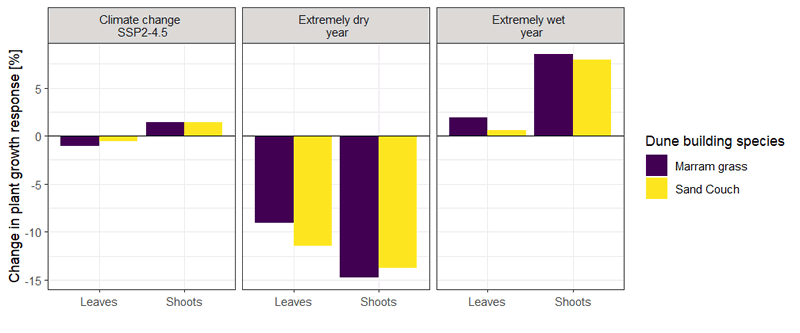J.-M. Homberger1*, A. Lynch2, M. Riksen1, J. Limpens1
1 Wageningen University and Research, Environmental, Department of Environmental Sciences, the Netherlands; 2 Vecta, Wellington, New Zealand
*corresponding author:
Introduction
Dune-building grasses are important for coastal protection. They promote topographic stability and development due to their traits that facilitate dune formation: Perennial grass species such as marram grass (Ammophila arenaria) and sand couch (Elytrigia juncea) respond to burial by sediment with enhanced growth while also trapping sediments effectively. In this context, species like marram grass have been used as ecosystem engineer in both past and recent dune restoration projects. Whether this solution will be applicable in future depends on climate change. While past research already established a link between precipitation and dune development (Hesp et al., 2021), the direct response of dune building grasses to precipitation has not been quantified to this date.
Methods
We explored the response of dune building grasses to summer precipitation in a two-step approach. We first used a pot-experiment to derive species growth relationships with water availability for marram grass and sand couch. To this end, we treated pots with different levels of water as derived from past summer precipitation records while monitoring the plant response. In a second step we used statistical models to predict the impact of changes in summer precipitation on the growth of these species. We explored three scenarios of changes to long-term average precipitation: climate change (+ 4.7%), a recent extremely dry year (-23 %) and a recent extremely wet year (+ 33%).
Results
We found that both marram grass and sand couch were sensitive to changes in water availability and responded positively to an increase in it. Comparing pot soil moisture measurements to field measurements showed that field moisture tended be on the lower end of ranges in pots. This suggests that dune grasses in the field are susceptible to drought effects. In the precipitation scenarios, plant growth was most affected for the extremely dry year (up to -14.8%), followed by the extremely wet year (up to +8.5%) and least affected in the climate change scenario (up to +1.4 %) (Figure 1).

Figure 1: Change in dune building species growth response for different precipitation scenarios.
A bigger change in plant growth during extreme climate events implies a higher impact on dune development and stability. Including relationships between plant growth and climate in coastal models are thus needed to improve the predictions of climate change impacts on topography development.
References
Hesp, P.A., Hernández-Calvento, L., Gallego-Fernández, J.B., Miot da Silva, G., Hernández-Cordero, A.I., Ruz, M., Romero, L.G., 2021. Nebkha or not? -Climate control on foredune mode. J. Arid Environ. 187. https://doi.org/10.1016/j.jaridenv.2021.104444
I. Surname1*, F.N. Another-Surname2 , Y. Next-Surname2
1 University Name, Country; 2 Organization Name, Country
* Corresponding author: mail.name@organization.org


